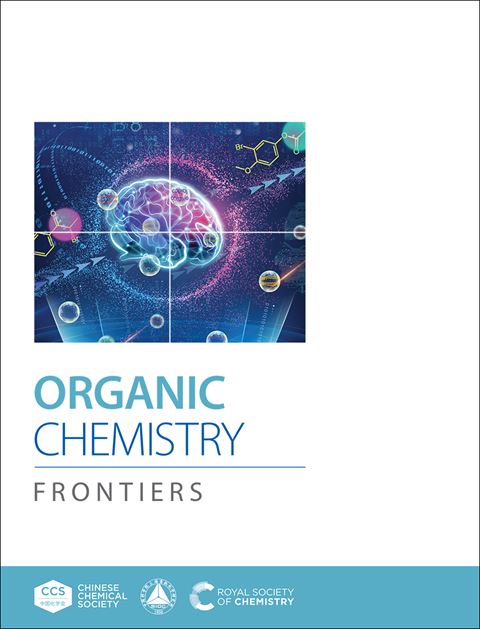间或对取代三苯胺[3]芳烃的流线型合成及其在多面体笼中的分层组装
IF 4.7
1区 化学
Q1 CHEMISTRY, ORGANIC
引用次数: 0
摘要
三苯胺[3]-芳烃(TPA[3] -芳烃)是一类新型的大环支架,在超分子化学领域具有显著的应用潜力。在这项研究中,我们通过BF3•et20催化的一锅Friedel-Crafts反应,在5分钟内获得了接近定量的产率,在氮桥单元上具有间位或对取代的溴苯基或酯基团的TPA bbb50的流线型合成。这些位于赤道位置的不稳定取代基能够在温和的条件下实现高效的环化后功能化,促进了各种官能团的引入,包括硝基苯、芘、三联吡啶和羧酸单位。这些元功能化的TPA[3]具有特殊的结构灵活性,使其能够通过子组件自组装策略用作构建金属有机笼(moc)的三主题构建块。通过精确调整配体密度和金属配位,我们合成了多种moc,包括四面体M4L4笼,二聚体M3L2组装体和八面体M6L4结构。这些结果证明了TPA[3]支架在推进分层超分子组装方面的多功能性,并突出了它们在创建结构多样化和定义良好的超分子结构方面的潜力。本文章由计算机程序翻译,如有差异,请以英文原文为准。
Streamlined synthesis of meta- or para-substituted triphenylamine[3]arenes and their hierarchical assembly into polyhedral cages
Triphenylamine[3]arenes (TPA[3]s) are a novel class of macrocyclic scaffolds with remarkable potential in supramolecular chemistry. In this study, we present a streamlined synthesis of TPA[3]s featuring meta or para-substituted bromophenyl or ester moieties on the nitrogen-bridging units via a BF3 •Et2O-catalysed one-pot Friedel-Crafts reaction, achieving up to nearquantitative yields within five minutes. These labile substituents at the equatorial positions enable efficient post-cyclisation functionalisation under mild conditions, facilitating the introduction of diverse functional groups, including nitrophenyl, pyrene, terpyridine, and carboxylic acid units. These meta-functionalised TPA[3]s exhibit exceptional structural flexibility, enabling their use as tri-topic building blocks for the construction of metal-organic cages (MOCs) through a subcomponent self-assembly strategy. By precisely tuning ligand denticity and metal coordination, we synthesised a diverse range of MOCs, including tetrahedral M4L4 cages, dimeric M3L2 assemblies, and octahedral M6L4 architectures. These results demonstrate the versatility of TPA[3] scaffolds in advancing hierarchical supramolecular assembly and highlight their potential for creating structurally diverse and well-defined supramolecular architectures.
求助全文
通过发布文献求助,成功后即可免费获取论文全文。
去求助
来源期刊

Organic Chemistry Frontiers
CHEMISTRY, ORGANIC-
CiteScore
7.90
自引率
11.10%
发文量
686
审稿时长
1 months
期刊介绍:
Organic Chemistry Frontiers is an esteemed journal that publishes high-quality research across the field of organic chemistry. It places a significant emphasis on studies that contribute substantially to the field by introducing new or significantly improved protocols and methodologies. The journal covers a wide array of topics which include, but are not limited to, organic synthesis, the development of synthetic methodologies, catalysis, natural products, functional organic materials, supramolecular and macromolecular chemistry, as well as physical and computational organic chemistry.
 求助内容:
求助内容: 应助结果提醒方式:
应助结果提醒方式:


